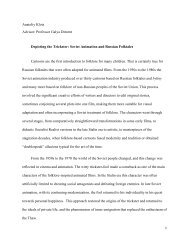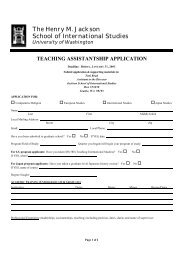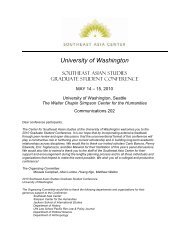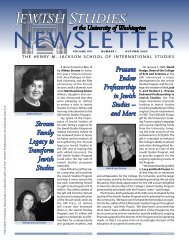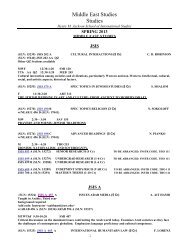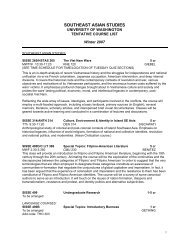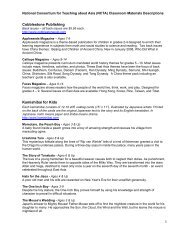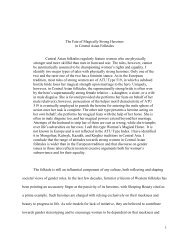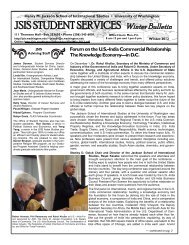Beyond Borders: Regional Partnerships in the Pacific Northwest
Beyond Borders: Regional Partnerships in the Pacific Northwest
Beyond Borders: Regional Partnerships in the Pacific Northwest
Create successful ePaper yourself
Turn your PDF publications into a flip-book with our unique Google optimized e-Paper software.
The Canadian Studies Center<br />
Henry M. Jackson School of International Studies<br />
Occasional Paper Series on<br />
Canada-U.S. Relations<br />
Dr. Sukumar Periwal<br />
<strong>Beyond</strong> <strong>Borders</strong>:<br />
<strong>Regional</strong> <strong>Partnerships</strong><br />
<strong>in</strong> <strong>the</strong> <strong>Pacific</strong> <strong>Northwest</strong><br />
February 2007
The Canadian Studies Centerr,<br />
Henry M. Jackson School<br />
of International Studies<br />
Occasional<br />
Paper Series on<br />
Canada-U.S.<br />
Relations<br />
Dr. Sukumar Periwal<br />
<strong>Beyond</strong> <strong>Borders</strong>:<br />
<strong>Regional</strong> <strong>Partnerships</strong><br />
<strong>in</strong> <strong>the</strong> <strong>Pacific</strong> <strong>Northwest</strong><br />
February 2007
Henry M. Jackson School of International Studies<br />
The Henry M. Jackson School of International Studies comb<strong>in</strong>es <strong>the</strong> social<br />
sciences, humanities, and professional fields to enhance our understand<strong>in</strong>g of<br />
our <strong>in</strong>creas<strong>in</strong>gly <strong>in</strong>terconnected globe. The school is named for <strong>the</strong> late Senator<br />
Henry M. Jackson, <strong>in</strong> recognition of his <strong>in</strong>terest and support for <strong>the</strong> school and<br />
for <strong>the</strong> field of <strong>in</strong>ternational affairs. The Jackson School’s commitment to regional,<br />
cross-cultural, and comparative studies extends well beyond <strong>the</strong> boundaries of its<br />
many formal academic programs. The school has eight Title VI National Resource<br />
Centers <strong>in</strong>clud<strong>in</strong>g Canadian Studies; East Asia Center; Center for West European<br />
Studies; International Studies; Middle East Studies; Ellison Center for Russian,<br />
East European, & Central Asian Studies; South Asian Studies; and Sou<strong>the</strong>ast Asian<br />
Studies – devoted to outreach and public education activities.<br />
Canadian Studies Center<br />
The Canadian Studies Center, one of <strong>the</strong> Jackson School’s eight Title VI centers,<br />
forms a National Resource Center with <strong>the</strong> Center for Canadian-American<br />
Studies at Western Wash<strong>in</strong>gton University. Founded <strong>in</strong> 1986, <strong>the</strong> Center promotes<br />
comparative Canadian content <strong>in</strong> <strong>the</strong> curriculum and with faculty and graduate<br />
research projects. Currently Canada is represented by faculty and research scientists<br />
<strong>in</strong> 17 departments <strong>in</strong> Arts and Sciences, 11 of <strong>the</strong> University’s professional schools<br />
and U.W. Seattle, Tacoma and Bo<strong>the</strong>ll. The Program hosts an undergraduate<br />
degree, a Professional Development Program for graduate students, and has<br />
a grant for Foreign Language and Area Studies Fellowships. The mission of <strong>the</strong><br />
Center is to <strong>in</strong>crease knowledge about Canada and <strong>the</strong> Canada-U.S. relationship<br />
at <strong>the</strong> University, with local bus<strong>in</strong>ess leaders and public officials, K-12 educators<br />
regionally and nationally, and <strong>the</strong> American general public.<br />
Canada-U.S. Fulbright Program<br />
The Canada-U.S. Fulbright Program is a bi-national program supported by<br />
<strong>the</strong> Government of Canada, through <strong>the</strong> Department of Foreign Affairs and<br />
International Trade Canada, <strong>the</strong> Government of <strong>the</strong> United States, through <strong>the</strong><br />
Department of State, and a large number of public and private sector partners.<br />
The mandate of <strong>the</strong> Canada-U.S. Fulbright Program is to enhance mutual<br />
understand<strong>in</strong>g between <strong>the</strong> people of Canada and <strong>the</strong> people of <strong>the</strong> United States<br />
by provid<strong>in</strong>g support to outstand<strong>in</strong>g graduate students, faculty, professionals and<br />
<strong>in</strong>dependent researchers.
Dr. Sukumar Periwal<br />
Dr. Sukumar Periwal is <strong>the</strong> first<br />
recipient of <strong>the</strong> new Fulbright Visit<strong>in</strong>g<br />
Chair <strong>in</strong> Canadian Studies at <strong>the</strong><br />
University of Wash<strong>in</strong>gton. Dr. Periwal,<br />
Director of International Relations for<br />
British Columbia’s Intergovernmental<br />
Relations Secretariat, took up <strong>the</strong><br />
Chair <strong>in</strong> Fall 2006 and will cont<strong>in</strong>ue<br />
his tenure until <strong>the</strong> end of W<strong>in</strong>ter<br />
Quarter 2007.<br />
The goal of <strong>the</strong> Chair is to <strong>in</strong>crease<br />
cross-border collaboration and<br />
effective mechanisms for dispute resolution that are central to ensur<strong>in</strong>g North<br />
America’s competitiveness <strong>in</strong> <strong>the</strong> global economy. As both a scholar and a<br />
practitioner, Dr. Periwal is <strong>in</strong> an ideal position to contribute to this pursuit.<br />
Dr. Periwal’s research project considers cross-border organizations and<br />
<strong>in</strong>tergovernmental l<strong>in</strong>kages <strong>in</strong> <strong>the</strong> <strong>Pacific</strong> <strong>Northwest</strong> <strong>in</strong> order to evaluate <strong>the</strong>ir<br />
effectiveness <strong>in</strong> resolv<strong>in</strong>g border issues and trade disputes, diffus<strong>in</strong>g bus<strong>in</strong>ess best<br />
practices and enhanc<strong>in</strong>g North American competitiveness. This research is relevant<br />
to Canada-U.S. relations, North American <strong>in</strong>tegration, border issues, <strong>in</strong>ternational<br />
trade and conflict resolution.<br />
Periwal completed his doctorate <strong>in</strong> <strong>in</strong>ternational relations at <strong>the</strong> University<br />
of Oxford and participated <strong>in</strong> <strong>the</strong> prestigious Canadian Governor General’s<br />
Leadership Conference <strong>in</strong> 2004. In addition to his work for <strong>the</strong> B.C. government,<br />
he also frequently facilitates courses at <strong>the</strong> University of British Columbia’s Centre<br />
for Intercultural Communication.
<strong>Beyond</strong> <strong>Borders</strong>:<br />
<strong>Regional</strong> <strong>Partnerships</strong><br />
<strong>in</strong> <strong>the</strong> <strong>Pacific</strong> <strong>Northwest</strong><br />
A new form of <strong>in</strong>ternational cooperation is tak<strong>in</strong>g shape <strong>in</strong> <strong>the</strong> <strong>Pacific</strong> <strong>Northwest</strong><br />
region of North America, an adaptive amalgam of known political arrangements<br />
and experimental modes of democratic dialogue and action. The bones of<br />
conventional bilateral and multilateral <strong>in</strong>tergovernmental agreements are be<strong>in</strong>g<br />
fleshed out with ad-hoc coalitions and work<strong>in</strong>g groups that are start<strong>in</strong>g to flex <strong>the</strong>ir<br />
muscle. And underly<strong>in</strong>g <strong>the</strong> formal structures, a flexible and <strong>in</strong>tertw<strong>in</strong>ed ‘neural<br />
network’ of regional organizations is stimulat<strong>in</strong>g <strong>in</strong>teraction and <strong>in</strong>formationshar<strong>in</strong>g<br />
between governments, bus<strong>in</strong>esses, activists and <strong>in</strong>digenous peoples, like a<br />
dense web of neurons spark<strong>in</strong>g more and more ideas and personal connections.<br />
WHAT MAKES THE PACIFIC NORTHWEST SPECIAL?<br />
The <strong>Pacific</strong> <strong>Northwest</strong> offers best practices <strong>in</strong> partner<strong>in</strong>g across borders with <strong>the</strong><br />
overall goal of promot<strong>in</strong>g <strong>the</strong> whole region’s global competitiveness to get beyond<br />
fruitless conflict and <strong>in</strong>creas<strong>in</strong>g beneficial cooperation. <strong>Regional</strong> cooperation <strong>in</strong><br />
<strong>the</strong> <strong>Pacific</strong> <strong>Northwest</strong> is special because of three def<strong>in</strong><strong>in</strong>g features:<br />
• First, <strong>the</strong> region is strategically located as a gateway between North America and<br />
<strong>the</strong> Asia <strong>Pacific</strong>, as a cross-border community between Canada and <strong>the</strong> United<br />
States, and as a network of vibrant urban centers <strong>in</strong>clud<strong>in</strong>g Vancouver, Seattle,<br />
Calgary, Edmonton, Boise, Portland and Victoria.<br />
• Second, an <strong>in</strong>tense and <strong>in</strong>formed dialogue on economic and environmental<br />
susta<strong>in</strong>ability among activists, bus<strong>in</strong>esses, and governments has led to efforts<br />
to bridge <strong>the</strong> divides between natural resource extraction and environmental<br />
protection through <strong>in</strong>novative partnerships and technology <strong>in</strong>novation that<br />
are showcased at <strong>in</strong>ternationally recognized events such as <strong>the</strong> biannual Globe<br />
conference and <strong>the</strong> upcom<strong>in</strong>g 2010 W<strong>in</strong>ter Olympic and Paralympic Games <strong>in</strong><br />
Vancouver.<br />
• Third, <strong>the</strong> structural l<strong>in</strong>kages between <strong>the</strong> states and prov<strong>in</strong>ces of <strong>the</strong> <strong>Pacific</strong><br />
<strong>Northwest</strong> – bilateral and multilateral agreements on economic cooperation<br />
| 7 |
and emergency preparedness – provide a critical impetus for o<strong>the</strong>r issue-specific<br />
coalitions, alliances and partnerships. These ‘bottom-up’ <strong>in</strong>itiatives, often fostered<br />
and encouraged by an <strong>in</strong>novative regional organization called <strong>the</strong> <strong>Pacific</strong> North<br />
West Economic Region (PNWER), enable <strong>the</strong> region to identify and articulate<br />
shared priorities and concerns with a dist<strong>in</strong>ctive voice.<br />
As <strong>the</strong> center of economic gravity shifts towards <strong>the</strong> <strong>Pacific</strong> Rim, this model of<br />
regional partnership will become <strong>in</strong>creas<strong>in</strong>gly important for <strong>the</strong> future prosperity<br />
and security of North America and as a role model for regions <strong>in</strong> o<strong>the</strong>r parts of<br />
<strong>the</strong> world. After September 11, 2001, it is no longer possible to argue that <strong>the</strong><br />
nation-state is irrelevant <strong>in</strong> an age of globalization. The grim reality of terrorism<br />
and <strong>in</strong>ternational violence has re<strong>in</strong>forced <strong>the</strong> state’s primary role as <strong>the</strong> provider<br />
of security for its citizens. However, <strong>the</strong> dizzy<strong>in</strong>g technological, economic and<br />
demographic shifts that are mak<strong>in</strong>g <strong>the</strong> world ‘flat’ (<strong>in</strong> Thomas Friedman’s term)<br />
cont<strong>in</strong>ue to accelerate as well. S<strong>in</strong>ce 9/11, <strong>the</strong> key challenge for policy makers has<br />
been to reconcile <strong>the</strong> often contradictory imperatives of security and prosperity.<br />
Cross-border regional cooperation <strong>in</strong> <strong>the</strong> <strong>Pacific</strong> <strong>Northwest</strong> offers useful lessons <strong>in</strong><br />
how to use borders, not as ever higher walls of suspicion and sullen <strong>in</strong>sularity, but<br />
as good fences that make even better neighbors who are able to learn from each<br />
o<strong>the</strong>r and profit from our differences.<br />
Globalization has caused, and also made us more aware of, <strong>the</strong> complex challenges<br />
humans face as a species <strong>in</strong> <strong>the</strong> first half of <strong>the</strong> 21st century. Climate change with<br />
its manifold associated impacts (<strong>in</strong>clud<strong>in</strong>g floods, droughts, ris<strong>in</strong>g coastal water<br />
levels and chang<strong>in</strong>g flows of ocean currents, <strong>the</strong> melt<strong>in</strong>g of glaciers and snowpacks,<br />
species migration and ext<strong>in</strong>ction, and ris<strong>in</strong>g energy requirements and constra<strong>in</strong>ts),<br />
<strong>the</strong> renewed and unpredictable onslaught of deadly diseases that may resist exist<strong>in</strong>g<br />
medic<strong>in</strong>es and be able to mutate faster than our capacity to generate vacc<strong>in</strong>es, <strong>the</strong><br />
horrify<strong>in</strong>g effects of natural catastrophes like earthquakes and tsunamis, magnified<br />
<strong>in</strong> an age of unprecedented urban concentration – all <strong>the</strong>se challenges demand<br />
global responses that have not been forthcom<strong>in</strong>g from a fragmented <strong>in</strong>ternational<br />
community composed of nation-states that are for <strong>the</strong> most part paralyzed by<br />
partisan politics, powerful domestic lobbies and short-sighted self-<strong>in</strong>terest.<br />
Too often, <strong>in</strong>tergovernmental responses are half-hearted agreements designed to<br />
achieve maximum publicity while only meet<strong>in</strong>g <strong>the</strong> lowest common denom<strong>in</strong>ator,<br />
too late and too little, and rarely, if ever, actually implemented. While governments<br />
are usually effective at deliver<strong>in</strong>g specific programs <strong>in</strong> designated areas of<br />
jurisdiction for which political leaders believe <strong>the</strong>re is a popular mandate, <strong>the</strong>y<br />
| 8 |
are not designed to respond proactively to challenges that exceed <strong>the</strong>ir scope and<br />
capacity to deliver results. As members of a species organized <strong>in</strong>to political units<br />
that are dysfunctional for deal<strong>in</strong>g with challenges beyond <strong>the</strong>ir particular grasp,<br />
our behavior resembles <strong>the</strong> frog sitt<strong>in</strong>g <strong>in</strong> a pot of water that is gradually be<strong>in</strong>g<br />
heated up. The frog’s <strong>in</strong>ability to grasp what is happen<strong>in</strong>g as <strong>the</strong> water approaches<br />
boil<strong>in</strong>g po<strong>in</strong>t is perilously similar to our own state of denial.<br />
In contrast, <strong>the</strong> noted economist Amartya Sen offers ano<strong>the</strong>r story of a frog “that<br />
is born <strong>in</strong> a well, and stays <strong>in</strong> <strong>the</strong> well and lives its entire life <strong>in</strong> <strong>the</strong> well. It has a<br />
worldview that consists of <strong>the</strong> well… That was what <strong>the</strong> world was like for many<br />
people on <strong>the</strong> planet before <strong>the</strong> fall of <strong>the</strong> [Berl<strong>in</strong>] wall. When it fell, it was like<br />
<strong>the</strong> frog <strong>in</strong> <strong>the</strong> well was suddenly able to communicate with frogs <strong>in</strong> all <strong>the</strong> o<strong>the</strong>r<br />
wells…. If I celebrate <strong>the</strong> fall of <strong>the</strong> wall, it is because I am conv<strong>in</strong>ced of how much<br />
we can learn from each o<strong>the</strong>r. Most knowledge is learn<strong>in</strong>g from o<strong>the</strong>rs across <strong>the</strong><br />
border.”<br />
The fall of <strong>the</strong> Berl<strong>in</strong> Wall <strong>in</strong> November 1989 <strong>in</strong>spired a few visionary legislators<br />
on <strong>the</strong> o<strong>the</strong>r side of <strong>the</strong> planet to come up with a new way of ‘learn<strong>in</strong>g from o<strong>the</strong>rs<br />
across <strong>the</strong> border.’ Alberta’s Deputy Premier Jim Horsman and Wash<strong>in</strong>gton State<br />
Senate President pro tem Alan Bluechel reasoned that two rich and self-confident<br />
countries like Canada and <strong>the</strong> United States with a history of trust, cooperation<br />
and shared traditions of democracy, <strong>the</strong> rule of law and free markets, would be able<br />
to cooperate effectively at <strong>the</strong> regional level to f<strong>in</strong>d mutual w<strong>in</strong>s. Toge<strong>the</strong>r with<br />
like-m<strong>in</strong>ded leaders <strong>in</strong> neighbour<strong>in</strong>g jurisdictions, <strong>the</strong>y established a forum for<br />
legislators that soon evolved <strong>in</strong>to a regional partnership <strong>in</strong>clud<strong>in</strong>g <strong>the</strong> private sector.<br />
The <strong>in</strong>itial effort has s<strong>in</strong>ce grown <strong>in</strong>to a remarkable regional network that has<br />
spread throughout <strong>the</strong> <strong>Pacific</strong> <strong>Northwest</strong>, becom<strong>in</strong>g an alternative way to generate<br />
<strong>in</strong>novative ideas, experiment on a small scale, and share ‘best practices’ with o<strong>the</strong>rs<br />
<strong>in</strong> <strong>the</strong> region who also face similar challenges. This ‘open source’ approach stands<br />
<strong>in</strong> radical contrast to <strong>the</strong> ‘top-down’ model of traditional <strong>in</strong>ternational <strong>in</strong>teraction<br />
based on <strong>the</strong> nation-state as <strong>the</strong> only legitimate actor on <strong>the</strong> <strong>in</strong>ternational arena.<br />
THE VALUE OF THE REGION<br />
To date, regional cooperation <strong>in</strong> <strong>the</strong> <strong>Pacific</strong> <strong>Northwest</strong> has mostly consisted of<br />
dialogue among legislators, private sector leaders and government officials. Results<br />
have not gone much beyond mak<strong>in</strong>g contact with counterparts and potential<br />
partners, shar<strong>in</strong>g <strong>in</strong>formation and potential “best practices”, and jo<strong>in</strong>t advocacy<br />
to decision-makers at <strong>the</strong> federal level. There have been no concerted efforts to<br />
| 9 |
establish structures or <strong>in</strong>stitutions with sufficient mandate, popular legitimacy and<br />
resources to make decisions at <strong>the</strong> regional level. If one buys <strong>in</strong>to an “<strong>in</strong>stitutional”<br />
model of regionalism or governance, it would be easy to dismiss <strong>the</strong>se cooperative<br />
efforts as <strong>the</strong> attempts, with limited success, by peripheral elites to coord<strong>in</strong>ate <strong>the</strong>ir<br />
voices so that <strong>the</strong>y can ga<strong>in</strong> greater hear<strong>in</strong>g at <strong>the</strong> centre, where fund<strong>in</strong>g, power and<br />
legitimacy are located and decisions really get made. After all, both Canada and<br />
<strong>the</strong> United States are successful states, able to provide <strong>the</strong>ir citizens with very high<br />
levels of economic and environmental well-be<strong>in</strong>g through considerable <strong>in</strong>vestment<br />
<strong>in</strong> public <strong>in</strong>frastructure and manageable levels of taxation and debt. Fur<strong>the</strong>rmore,<br />
despite long-term trends of decreas<strong>in</strong>g voter turnout and <strong>the</strong> political divides created<br />
by closely contested elections, both federal governments can claim a reasonable<br />
measure of legitimacy as represent<strong>in</strong>g more or less functional democracies.<br />
From this perspective, prov<strong>in</strong>ces, states and o<strong>the</strong>r regional actors are relatively<br />
marg<strong>in</strong>al decision-makers who would be best advised to stick to <strong>the</strong>ir knitt<strong>in</strong>g and<br />
provide services <strong>in</strong> <strong>the</strong>ir areas of jurisdiction and competency, such as education,<br />
health care, and public safety, where room for cross-border cooperation has<br />
historically been relatively limited due to systemic differences. A state-centric<br />
approach to cross-border cooperation, <strong>the</strong>n, would see limited scope for regional<br />
cooperation, ei<strong>the</strong>r on a bilateral level between neighbour<strong>in</strong>g states and prov<strong>in</strong>ces,<br />
or multilaterally through regional organizations.<br />
At first sight, <strong>the</strong> lack of <strong>in</strong>stitution-build<strong>in</strong>g on <strong>the</strong> regional level would appear<br />
to support <strong>the</strong> centralist argument that <strong>the</strong>re is not much appetite or capacity for<br />
significant regional cooperation. This approach assumes a correlation between <strong>the</strong><br />
existence of an <strong>in</strong>stitutional apparatus and <strong>the</strong> ability to deliver results. However, as<br />
James Hillman has po<strong>in</strong>ted out, <strong>the</strong> network has become <strong>the</strong> preferred contemporary<br />
concept for power: “<strong>the</strong> images of flow, feedback, distributive energy, touch<strong>in</strong>g<br />
all <strong>the</strong> bases, balanc<strong>in</strong>g constituencies, delivery - an <strong>in</strong>determ<strong>in</strong>ate field of almost<br />
random forces - are <strong>the</strong> new images of power. Not <strong>the</strong> heart but <strong>the</strong> capillaries.” A<br />
network <strong>the</strong>ory of power would value contacts over <strong>in</strong>stitutions, access ra<strong>the</strong>r than<br />
formal negotiations, consensus ra<strong>the</strong>r than b<strong>in</strong>d<strong>in</strong>g legal <strong>in</strong>struments and treaty<br />
obligations.<br />
Understand<strong>in</strong>g power as a network is especially relevant to Canada-U.S. relations<br />
for five reasons:<br />
• First, <strong>the</strong> U.S. political system structurally supports a diffusion of power among<br />
different actors, through constitutional means such as checks and balances<br />
| 10 |
etween <strong>the</strong> three branches of government and <strong>the</strong> often reiterated doctr<strong>in</strong>e of<br />
states' rights, and also through relatively loose party discipl<strong>in</strong>e and <strong>the</strong> capacity<br />
of <strong>in</strong>dividual legislators to act <strong>in</strong> <strong>the</strong>ir particular constituents' (and <strong>the</strong>ir own<br />
political) <strong>in</strong>terests.<br />
• Second, <strong>the</strong> differences <strong>in</strong> size and structure between <strong>the</strong> U.S. federal system and<br />
<strong>the</strong> Canadian confederation require <strong>in</strong>creased understand<strong>in</strong>g, not just from <strong>the</strong><br />
perspective of <strong>the</strong> center, but also from <strong>the</strong> periphery. A state like California,<br />
for <strong>in</strong>stance, has a population of 32 million, more than all of Canada. Yet <strong>the</strong><br />
Governor of California is only one of fifty governors, each compet<strong>in</strong>g for national<br />
attention and <strong>in</strong>ternational stand<strong>in</strong>g, work<strong>in</strong>g with<strong>in</strong> a complex political context<br />
<strong>in</strong>volv<strong>in</strong>g U.S. Senators, state legislators, and o<strong>the</strong>r state-wide elected and<br />
appo<strong>in</strong>ted officials. In o<strong>the</strong>r words, a Canadian legislator or bureaucrat needs<br />
to recognize <strong>the</strong> cognitive dissonance with an American counterpart with very<br />
different jurisdictional scope and capacity.<br />
• Third, <strong>the</strong> proliferation and highly vocal articulation of <strong>in</strong>terests has fragmented<br />
<strong>the</strong> once predictable nature of <strong>in</strong>fluence and stakeholder op<strong>in</strong>ion. Although <strong>the</strong><br />
value added by traditional lobby<strong>in</strong>g will cont<strong>in</strong>ue to rema<strong>in</strong> a useful means to<br />
sift through <strong>the</strong> <strong>in</strong>formation barrage faced by busy politicians and <strong>the</strong>ir staffers,<br />
<strong>the</strong> ability to pull toge<strong>the</strong>r coalitions of diverse <strong>in</strong>terests that bridge <strong>in</strong>dustry,<br />
constituency and political divides has become <strong>in</strong>creas<strong>in</strong>gly important.<br />
• Fourth, regional cooperation enables governments to <strong>in</strong>teract more effectively<br />
with grass-roots democracy by br<strong>in</strong>g<strong>in</strong>g <strong>in</strong> expertise <strong>in</strong> implementation and <strong>the</strong><br />
capacity to veto ideas that would have negative effects. Conversely, participation<br />
by democratically elected legislators adds legitimacy to <strong>the</strong> grass-roots effort.<br />
• Lastly, global challenges require a more open, <strong>in</strong>clusive and decentralized<br />
approach to many decisions. Thanks to <strong>the</strong> exponential rapidity with which<br />
global transmission and communication modes have evolved, a biological or<br />
electronic <strong>in</strong>fection that orig<strong>in</strong>ated <strong>in</strong> a seem<strong>in</strong>gly remote location now has <strong>the</strong><br />
potential to become a global pandemic with a speed that cannot be dealt with by a<br />
traditional “command and control” model of decision-mak<strong>in</strong>g. In crisis situations,<br />
communications l<strong>in</strong>es with <strong>the</strong> centre may break down and local authorities may<br />
be forced to act <strong>in</strong>dependently and utilis<strong>in</strong>g ad hoc networks. These ‘coalitions<br />
of <strong>the</strong> available’ may be aligned on a rough functional subsidiarity and familiarity<br />
with colleagues across organizational and national divides. Trust is <strong>the</strong> key to<br />
work<strong>in</strong>g effectively toge<strong>the</strong>r.<br />
| 11 |
The region will not replace <strong>the</strong> nation-state, just as <strong>the</strong> ‘open source’ <strong>in</strong>tellectual<br />
commons movement will not displace <strong>the</strong> corporation. However, <strong>the</strong>se new<br />
self-organized collaborative communities are re<strong>in</strong>vent<strong>in</strong>g politics and bus<strong>in</strong>ess,<br />
<strong>in</strong>creas<strong>in</strong>g transactional efficiencies and voluntary participation <strong>in</strong> <strong>the</strong> public arena.<br />
As adaptive networks, <strong>the</strong>y <strong>in</strong>crease our overall capacity to respond to complex<br />
challenges <strong>in</strong> timely and <strong>in</strong>novative ways. The state could use <strong>the</strong> assistance<br />
of regional networks to <strong>in</strong>crease voluntary participation <strong>in</strong> public life, renew<br />
democracy and f<strong>in</strong>d solutions for challenges beyond its own capacity. As social<br />
forms predicated on trust, <strong>the</strong>se collaborative communities improve our overall<br />
capacity to both compete and cooperate for mutual benefit. Instead of sitt<strong>in</strong>g <strong>in</strong><br />
our pot quietly stew<strong>in</strong>g, we strike up friendships with <strong>the</strong> o<strong>the</strong>r frogs that enable<br />
us to discover common concerns and shared solutions.<br />
BENEFITS OF REGIONAL COOPERATION<br />
The key benefits of regional cooperation are: first, <strong>in</strong>creas<strong>in</strong>g prosperity through<br />
regulatory cooperation and promot<strong>in</strong>g cross-border trade and <strong>in</strong>vestment; second,<br />
actively facilitat<strong>in</strong>g <strong>the</strong> resolution of border issues and trade conflicts; and third,<br />
enhanc<strong>in</strong>g North America’s global competitiveness.<br />
Increas<strong>in</strong>g prosperity<br />
There is a significant disparity between, on <strong>the</strong> one hand, <strong>the</strong> enormous volumes of<br />
cross-border trade and economic <strong>in</strong>terdependence between Canada and <strong>the</strong> United<br />
States, and, on <strong>the</strong> o<strong>the</strong>r hand, <strong>the</strong> ostentatious lack of high-level vision and political<br />
engagement on <strong>the</strong> challenges <strong>the</strong> countries face, both bilaterally and <strong>in</strong> <strong>the</strong> trilateral<br />
North American context. Economic and political discussions among governments<br />
cont<strong>in</strong>ue to take place <strong>in</strong> a dist<strong>in</strong>ctively North American way – through low-key<br />
work<strong>in</strong>g groups, focused on pragmatic and immediate concerns, often driven by<br />
<strong>the</strong> private sector, and with m<strong>in</strong>imal <strong>in</strong>vestment <strong>in</strong> <strong>in</strong>stitution-build<strong>in</strong>g. As Gary<br />
Clyde Hufbauer and Jeffrey Schott observe, “NAFTA was designed with m<strong>in</strong>imal<br />
<strong>in</strong>stitutional structures; none of <strong>the</strong> partners wanted to grant authority to a new<br />
regional bureaucracy. The restra<strong>in</strong>t was too severe. NAFTA’s skeletal <strong>in</strong>stitutional<br />
structure has impeded <strong>the</strong> achievement of certa<strong>in</strong> core objectives.”<br />
The groundwork laid by <strong>the</strong> Security and Prosperity Partnership (SPP) between<br />
Canada, <strong>the</strong> United States and Mexico is significant, <strong>in</strong> creat<strong>in</strong>g a substantive North<br />
American context for regulatory cooperation. Many of <strong>the</strong> specific <strong>in</strong>itiatives<br />
mentioned <strong>in</strong> <strong>the</strong> Leaders’ Statements and M<strong>in</strong>isters’ Reports reflect work that has<br />
| 12 |
een tak<strong>in</strong>g place <strong>in</strong> <strong>the</strong> <strong>Pacific</strong> <strong>Northwest</strong> for years. The SPP translates some of<br />
<strong>the</strong>se regional activities to <strong>the</strong> bilateral and trilateral levels, provid<strong>in</strong>g an additional<br />
validation for <strong>the</strong> regional efforts. Most importantly, regional cooperation on trade<br />
between states and prov<strong>in</strong>ces adds ano<strong>the</strong>r much-needed dimension of democratic<br />
legitimacy to North American economic cooperation.<br />
This mode of voluntary bilateral or multilateral cooperation (ra<strong>the</strong>r than Europeanstyle<br />
<strong>in</strong>tegration that has built <strong>in</strong>fluential transnational policy networks and powerful<br />
supranational <strong>in</strong>stitutions that have been formalized through <strong>in</strong>tergovernmental<br />
conferences, treaties and even constitutional efforts) fits well with <strong>the</strong> ‘variable<br />
geometry’ of regional cooperation <strong>in</strong> <strong>the</strong> <strong>Pacific</strong> <strong>Northwest</strong>, which has advanced<br />
North American economic prosperity through regulatory cooperation, promot<strong>in</strong>g<br />
cross-border trade and <strong>in</strong>vestment, and protect<strong>in</strong>g vital economic assets such as <strong>the</strong><br />
critical <strong>in</strong>frastructure of pipel<strong>in</strong>es, energy transmission and <strong>in</strong>formation corridors<br />
that underp<strong>in</strong>s a modern <strong>in</strong>dustrial economy.<br />
September 11, 2001 and Hurricane Katr<strong>in</strong>a demonstrated <strong>the</strong> previously unseen<br />
connection between security, emergency preparedness and prosperity. Governments<br />
and private <strong>in</strong>dustry <strong>in</strong> <strong>the</strong> <strong>Pacific</strong> <strong>Northwest</strong> were quick to recognize <strong>the</strong> need to<br />
protect vital <strong>in</strong>terdependent economic assets such as pipel<strong>in</strong>es, energy transmission<br />
l<strong>in</strong>es and telecommunications networks that are <strong>the</strong> basic underp<strong>in</strong>n<strong>in</strong>g of trade<br />
and daily economic life <strong>in</strong> both countries. <strong>Regional</strong> organizations and political<br />
leaders played an important role <strong>in</strong> <strong>in</strong>creas<strong>in</strong>g awareness of <strong>the</strong> need for improved<br />
critical <strong>in</strong>frastructure protection and streng<strong>the</strong>n<strong>in</strong>g cooperation between Canada<br />
and <strong>the</strong> United States on economic and homeland security <strong>in</strong> <strong>the</strong> post 9/11<br />
<strong>in</strong>ternational context.<br />
Resolv<strong>in</strong>g disputes<br />
<strong>Regional</strong> organizations have also been <strong>in</strong>strumental <strong>in</strong> build<strong>in</strong>g trust – a prerequisite<br />
for resolv<strong>in</strong>g border issues and trade conflicts. Participat<strong>in</strong>g <strong>in</strong> regional dialogue<br />
has enabled legislators and private sector leaders to build trust through regular<br />
<strong>in</strong>teraction, understand each o<strong>the</strong>r’s perspective, streng<strong>the</strong>n personal ties, let go<br />
of suspicion and defensiveness, identify common <strong>in</strong>terests, assess <strong>the</strong> costs and<br />
benefits of cooperat<strong>in</strong>g (or not), f<strong>in</strong>d solutions, contribute regional perspectives to<br />
<strong>the</strong> national dialogue, and revitalize <strong>in</strong>stitutions. Regular <strong>in</strong>teraction has enabled<br />
<strong>the</strong> region to wea<strong>the</strong>r stra<strong>in</strong>s on <strong>the</strong> overall Canada-U.S. relationship that arose<br />
between 2001-2005 due to contentious issues like <strong>the</strong> Iraq war, <strong>the</strong> softwood<br />
lumber trade dispute and restrictions on cattle exports. <strong>Regional</strong> actors have<br />
| 13 |
also been pivotal <strong>in</strong> shap<strong>in</strong>g discussions on how to make <strong>the</strong> Canada-U.S. border<br />
work more effectively <strong>in</strong> promot<strong>in</strong>g security while facilitat<strong>in</strong>g legitimate trade and<br />
tourism. The active advocacy of regional organizations and coalitions <strong>in</strong> <strong>the</strong> <strong>Pacific</strong><br />
<strong>Northwest</strong> has recast <strong>the</strong> proposed U.S. Western Hemisphere Travel Initiative and<br />
regional Premiers and Governors have promoted <strong>in</strong>novative alternatives such as <strong>the</strong><br />
BC-Wash<strong>in</strong>gton Enhanced Drivers’ License pilot project. The <strong>Pacific</strong> <strong>Northwest</strong><br />
is also <strong>the</strong> site of highest NEXUS card uptake and is seen as <strong>the</strong> ‘test bed’ for<br />
<strong>in</strong>tegrated ‘smart border’ solutions by <strong>the</strong> two federal governments.<br />
Cooperation at <strong>the</strong> regional level can streng<strong>the</strong>n goodwill and build relationships<br />
that revitalize <strong>in</strong>stitutional arrangements (such as <strong>the</strong> International Jo<strong>in</strong>t<br />
Commission and <strong>the</strong> BC-Wash<strong>in</strong>gton Environmental Cooperation Council),<br />
transform<strong>in</strong>g <strong>the</strong>m <strong>in</strong>to effective social networks. In particular, transboundary<br />
environmental issues over water allocation and watersheds such as disputes over<br />
<strong>the</strong> Columbia, St Mary/Milk, and Fla<strong>the</strong>ad river bas<strong>in</strong>s are be<strong>in</strong>g dealt with <strong>in</strong> a<br />
cooperative way at <strong>the</strong> regional and local levels. The successful resolution of <strong>the</strong><br />
high profile issue of <strong>the</strong> flush<strong>in</strong>g of screened raw sewage by Victoria <strong>in</strong>to <strong>the</strong> Strait<br />
of Juan de Fuca illustrates <strong>the</strong> impact of regional collaboration <strong>in</strong> creat<strong>in</strong>g <strong>the</strong><br />
political climate and leadership required to resolve longstand<strong>in</strong>g and challeng<strong>in</strong>g<br />
transboundary environmental issues.<br />
Enhanc<strong>in</strong>g North American competitiveness<br />
The <strong>Pacific</strong> <strong>Northwest</strong> is <strong>the</strong> North American region that is most poised to benefit<br />
from global change as <strong>the</strong> world’s economic center of gravity shifts towards <strong>the</strong><br />
Asia <strong>Pacific</strong>. In a chang<strong>in</strong>g <strong>in</strong>ternational environment driven by <strong>the</strong> rise of Asian<br />
economic power, <strong>the</strong> rapid development of <strong>in</strong>formation and communication<br />
technologies and <strong>the</strong> new global competition for creative talent, regional cooperation<br />
can enhance North America’s competitive advantage <strong>in</strong> three key ways: <strong>in</strong>creased<br />
<strong>in</strong>novation and wealth creation; a stronger capacity to respond and recover from<br />
emerg<strong>in</strong>g challenges; and renew<strong>in</strong>g and enhanc<strong>in</strong>g exist<strong>in</strong>g social capital.<br />
<strong>Regional</strong> partnership enables new synergies that enhance competitiveness. <strong>Regional</strong><br />
bus<strong>in</strong>ess ‘clusters’ lead to higher levels of efficiency, <strong>in</strong>novation and bus<strong>in</strong>ess startups.<br />
A critical advantage of <strong>the</strong> federal structure <strong>in</strong> both Canada and <strong>the</strong> United<br />
States is that states and prov<strong>in</strong>ces are able to adopt diverse policies that enable <strong>the</strong>m<br />
to serve as ‘laboratories’ of public policy <strong>in</strong>novation and competitiveness. Both<br />
countries are complementary <strong>in</strong> that <strong>the</strong>y are similar and yet different enough to<br />
encourage bus<strong>in</strong>ess cross-fertilization and tourism.<br />
| 14 |
As a “networked region”, <strong>the</strong> <strong>Pacific</strong> <strong>Northwest</strong> illustrates <strong>the</strong> ways <strong>in</strong> which regional<br />
networks improve our capacity to respond to rapidly emerg<strong>in</strong>g complex challenges<br />
such as climate change and pandemic preparedness. <strong>Regional</strong> cooperation can<br />
streng<strong>the</strong>n North America’s capacity to respond to <strong>the</strong>se challenges through<br />
<strong>in</strong>creased <strong>in</strong>formation and resource shar<strong>in</strong>g on public health issues such as pandemic<br />
preparedness, a greater ability to mitigate disasters and <strong>in</strong>fluence national decisionmak<strong>in</strong>g<br />
on issues such as border closure <strong>in</strong> times of crisis, and an ability, as ‘adaptive<br />
systems,’ to generate solutions for issues aris<strong>in</strong>g from climate change.<br />
Regions that visibly value diversity are <strong>in</strong>creas<strong>in</strong>g <strong>the</strong>ir economic prosperity by<br />
attract<strong>in</strong>g highly mobile creative people and draw<strong>in</strong>g on <strong>the</strong>ir skills to renew and<br />
enhance exist<strong>in</strong>g forms of social capital. As Richard Florida has po<strong>in</strong>ted out,<br />
“Creative people choose regions.” The <strong>Pacific</strong> <strong>Northwest</strong> is a magnet for migrants<br />
because it offers both economic opportunity and quality of life. The creative<br />
class is attracted to locations with high levels of visible diversity and reputation<br />
for tolerance (such as Seattle, Vancouver and o<strong>the</strong>r <strong>Pacific</strong> <strong>Northwest</strong> locations).<br />
Lastly, geographical proximity to <strong>the</strong> Asia <strong>Pacific</strong> region and <strong>the</strong> presence of large<br />
diaspora communities are major assets at a time when several Asian countries are<br />
becom<strong>in</strong>g major trad<strong>in</strong>g partners and powerful actors <strong>in</strong> <strong>the</strong> global economy as<br />
important sources of <strong>in</strong>vestment capital, knowledge and skilled labor.<br />
CONCLUSION<br />
<strong>Regional</strong> cooperation is an effective way to <strong>in</strong>crease security and prosperity and<br />
enhance North America’s global competitiveness. Targeted <strong>in</strong>vestment <strong>in</strong> <strong>the</strong> social<br />
capital of regions <strong>in</strong>creases public awareness and support for regional <strong>in</strong>itiatives,<br />
streng<strong>the</strong>n<strong>in</strong>g <strong>in</strong>frastructure for cooperative efforts, enhanc<strong>in</strong>g synergy through<br />
connect<strong>in</strong>g regional groups, and showcas<strong>in</strong>g regions to <strong>the</strong> world. The local and<br />
<strong>the</strong> global fuse <strong>in</strong> <strong>the</strong> region, enabl<strong>in</strong>g us to get beyond our differences and f<strong>in</strong>d<br />
common cause.<br />
| 15 |
Canadian Studies Center Adm<strong>in</strong>istration<br />
Director/Chair: Daniel Hart<br />
Associate Director: Nad<strong>in</strong>e Fabbi<br />
Program Assistant: Marion Cook<br />
Student Assistants: Lana Harvey and Natalia Mart<strong>in</strong>ez-Paz<br />
Student Advisor: L<strong>in</strong>da Iltis<br />
Foreign Language and Area Studies Coord<strong>in</strong>ator: Mary Ann Curtis<br />
Study-<strong>in</strong>-Canada Advisor: Cameron Frisch<br />
Study-<strong>in</strong>-Québec Advisor: Anni Fuller<br />
Affiliated Canadian Studies Faculty, Research<br />
Scientists and Instructors<br />
2006-07 CENTER VISITING SCHOLARS<br />
Thierry Giasson, <strong>Pacific</strong> <strong>Northwest</strong> Québec Visit<strong>in</strong>g Scholar<br />
Sukumar Periwal, Canada-U.S. Fulbright Visit<strong>in</strong>g Chair<br />
COLLEGE OF ARTS AND SCIENCES<br />
AMERICAN ETHNIC STUDIES<br />
Tetsuden Kashima<br />
Gail Nomura<br />
AMERICAN INDIAN STUDIES<br />
Thomas G. Colonnese<br />
Charlotte Coté<br />
Alexandra Harmon<br />
Daniel Hart<br />
Dian Million<br />
Mary C. Wright<br />
ANTHROPOLOGY<br />
Benjam<strong>in</strong> Fitzhugh<br />
ART<br />
Christopher Ozubko<br />
Rob<strong>in</strong> Wright<br />
| 16 |<br />
COMMUNICATION<br />
Anthony Chan<br />
Kathleen Fearn-Banks<br />
Philip N. Howard<br />
EARTH & SPACE SCIENCES<br />
Ruth Ludw<strong>in</strong><br />
ECONOMICS<br />
Neil Bruce<br />
Shelly Lundberg<br />
ENGLISH<br />
Monika Kaup<br />
Leroy Searle<br />
ENVIRONMENT,<br />
PROGRAM ON THE<br />
David Secord<br />
ETHNOMUSICOLOGY<br />
Ter Ell<strong>in</strong>gson
FRENCH<br />
Denyse Delcourt<br />
GEOGRAPHY<br />
William Beyers<br />
Kim England<br />
J.W. Harr<strong>in</strong>gton<br />
Douglas Jackson<br />
Jonathan Mayer<br />
GLOBAL TRADE,<br />
TRANSPORTATION &<br />
LOGISTICS STUDIES<br />
Greg Shelton<br />
| 17 |<br />
HISTORY<br />
John F<strong>in</strong>dlay<br />
Richard Johnson<br />
L<strong>in</strong>da Nash<br />
INTERNATIONAL STUDIES,<br />
JACKSON SCHOOL OF<br />
Nad<strong>in</strong>e Fabbi<br />
LINGUISTICS<br />
Sharon Hargus<br />
Julia Herschensohn<br />
WOMEN’S STUDIES<br />
Luana Ross<br />
Shirley Yee<br />
COLLEGE OF ARCHITECTURE AND URBAN PLANNING<br />
URBAN DESIGN & PLANNING<br />
Daniel Abramson<br />
Hilda Blanco<br />
Branden Born<br />
Manish Chalana<br />
Dennis M. Ryan<br />
Anne Vernez-Moudon<br />
BUSINESS SCHOOL<br />
Debra Glassman<br />
COLLEGE OF ENGINEERING<br />
Graham Allan<br />
COLLEGE OF FOREST RESOURCES<br />
Ivan East<strong>in</strong><br />
Thomas H<strong>in</strong>ckley<br />
Dorothy Paun<br />
SCHOOL OF LAW<br />
Michael Rob<strong>in</strong>son-Dorn
SCHOOL OF MEDICINE<br />
HEALTH SERVICES<br />
Aaron Katz<br />
COLLEGE OF OCEAN AND FISHERY SCIENCES<br />
AQUATIC & FISHERY SCIENCES<br />
V<strong>in</strong>cent F. Gallucci<br />
Don Gunderson<br />
Ray Hilborn<br />
James R. Karr<br />
| 18 |<br />
MARINE AFFAIRS<br />
David Fluharty<br />
Wlodzimier Kaczynski<br />
OCEANOGRAPHY<br />
John Delaney<br />
Peter Rh<strong>in</strong>es<br />
DANIEL J. EVANS SCHOOL OF PUBLIC AFFAIRS<br />
Leigh Anderson<br />
SCHOOL OF PUBLIC HEALTH AND COMMUNITY MEDICINE<br />
Sarena Siefer<br />
Jack Thompson<br />
SCHOOL OF SOCIAL WORK<br />
Stan DeMello<br />
U.W. BOTHELL<br />
EDUCATION PROGRAM<br />
Cherry Banks<br />
U.W. TACOMA<br />
ECONOMICS<br />
Katie Baird<br />
EDUCATION<br />
Annette Henry<br />
LIBRARIES<br />
L<strong>in</strong>da Popp Di Biase<br />
Sion Roma<strong>in</strong>e<br />
SOCIAL WORK PROGRAM<br />
Janice Laakso
Canadian Studies Center<br />
Henry M. Jackson School of International Studies<br />
University of Wash<strong>in</strong>gton<br />
Box 353650<br />
Seattle, Wash<strong>in</strong>gton 98195<br />
canada@u.wash<strong>in</strong>gton.edu<br />
http://jsis.wash<strong>in</strong>gton.edu/canada/



